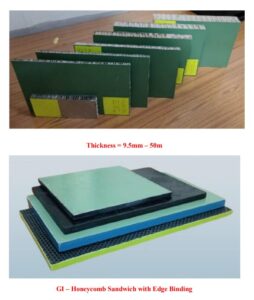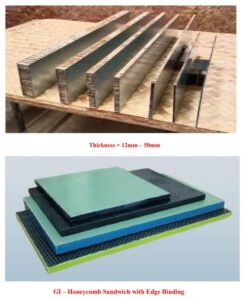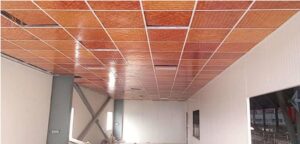In the fast-moving world of logistics and materials handling, the choice of pallet platform plays a crucial role in efficiency, cost, sustainability and durability. One innovative solution is the multi-utility bamboo composite pallet—engineered from high-performance bamboo-based composite materials. Below is a detailed blog-style guide on this product category, including description, properties, applications, pros & cons and FAQs—all informed by the published specification document.
What Are Multi-Utility Bamboo Composite Pallets?
A multi-utility bamboo composite pallet is a load-support platform manufactured using engineered bamboo composite materials (woven bamboo mats impregnated with resin, hot-pressed under high temperature) and designed with features such as quick-fix/removable legs, optional wheels, and ultra-light weight (as low as about 7 kg) while still offering strong load support. The product list from the specification resource states:
“Multi utility bamboo composite pallets:
a) Euro standard Pallets with quick fix and removable legs (1 min to fix or remove nine legs)
b) Pallets fixed with four wheels to use as trolley.
c) Light weight (just weighs 7 kg).”
These pallets build upon the same material technologies seen in bamboo composite boards: light weight, high strength, termite/fungus resistance, moisture resistance, etc. They differ by being designed for load-platform usage rather than strictly panel or furniture applications.
Key Properties & Specification Highlights
From the referenced specification documents, although not all data is dedicated to pallets, the underlying bamboo composite technology provides the following relevant traits:
Light weight: The pallet product description cites a weight of approximately 7 kg for the platform with removable legs.
High strength and stiffness: The boards/panels in the same material family show densities of ~740-790 kg/m³ for thin laminated boards, indicating a strong substrate relative to many wood panels.
Moisture/termite/fungus resistance: The product families list “boil water/moisture resistant, termite proof, non-fungus” among the properties.
Durability: The boards also carry “corrosion resistant, impact resistant” claims—beneficial for pallet use in heavy-duty or industrial environments.
Sustainability credentials: The material is described as “Eco-Friendly and sustainable.”
Although explicit load-capacity numbers for the pallet are not listed in the public summary, the combination of engineered bamboo composite material plus design features (removable legs or wheels) suggests a pallet platform capable of repeated use, modular support, and light-weight logistical advantage.
Applications for Industrial & Retail Use
Multi-utility bamboo composite pallets are well suited to a range of applications across industrial, retail, warehousing and export logistics. Key use-cases:
Warehouse storage and handling: For medium to heavy load platforms in manufacturing, distribution centres, where lighter pallets reduce dead-weight, handling cost and structural stress.
Retail display & reusable platforms: Pallets with removable legs or wheels allow adaptability to conversion into trolleys or display platforms in retail environments.
Export crates and reusable packaging: The moisture/termite resistant and durable nature of the material makes it suitable for export packaging where wooden pallets face phytosanitary or pest-treatment issues.
High turnover logistic circulation: Pallets that weigh less mean lower fuel/transport cost, faster manual handling, reduced strain on mechanised systems.
Green-logistics and circular use: Retailers, manufacturers and logistics operators pursuing sustainability can benefit from a high-performance, renewable material pallet rather than standard single-use wood or plastic pallets.
Advantages & Considerations
Advantages
Reduced dead-weight: The ~7 kg pallet weight (for the specified variant) offers a significant weight saving over many traditional wood pallets.
Performance in challenging environments: With moisture, termite, fungus and corrosion resistance, these pallets perform better in humid, outdoor or demanding logistic conditions.
Modularity & adaptability: Features such as quick-fix/removable legs or optional wheels enhance flexibility and reuse potential.
Sustainability story: Engineered bamboo composite is renewable, and long-life pallets reduce waste and replacement cost.
Differentiation: For businesses promoting eco-credentials or improved logistic performance, this pallet type can offer a distinctive value proposition.
Considerations / Limitations
Initial cost versus standard pallets: Engineered material plus modular design features may raise cost compared to commodity wood or plastic pallets; buyers must see value in lifecycle and performance.
Availability and supply chain: Being a specialized pallet type, logistics of supply, lead times, stocking and standardisation must be verified.
Load-capacity specification needed: While material properties are strong, actual pallet design load (static/dynamic) must be specified and matched to usage context.
Repair/maintenance model: The pallet design (removable legs, composite board) may require different maintenance or repair procedures compared to standard pallets—buyers must be aware.
End-of-life recycling: Although bamboo composite is renewable, composite constructions (resin-impregnated materials) may pose recycling or disposal considerations. Logistics operators should evaluate this for closed-loop reuse.
Frequently Asked Questions (FAQs)
Q: What load capacity can I expect from a multi-utility bamboo composite pallet?
A: The public specification sheet does not list specific dynamic/static load ratings for the pallet model. It is important to request manufacturer/designer load rating data (e.g., static load, dynamic load, racking load) before specifying. The material’s inherent high strength suggests good performance, but the structural design (legs, wheel support, board span) determines actual capacity.
Q: How do the removable legs work and is this suitable for frequent assembly/disassembly?
A: According to the product description, the pallet has quick-fix removable legs (nine legs) that can be attached or removed in about one minute. This feature supports modular use (flattening for transport, converting to display). For frequent assembly/disassembly, check fatigue life and joint integrity of the leg-to-platform attachment.
Q: Are these pallets suitable for export shipments?
A: Yes—they are made of engineered bamboo composite with termite/moisture resistance, which reduces worry about phytosanitary treatment which typically applies to untreated wood pallets. The durability and reuse potential also suit export crate use. However, confirm whether local regulations (e.g., ISPM-15) treat composite pallets similarly.
Q: How many reuse cycles can be expected relative to wood pallets?
A: While exact cycle life data is not provided in the summary, the durability claims (moisture/termite/fungus resistance, high strength composite) suggest a longer life than typical untreated wood pallets. For specification you should ask for test data on number of cycles, fatigue/impact performance, and expected maintenance.
Q: What maintenance or handling considerations apply?
A: Handling should respect composite board characteristics: avoid impact at edges, ensure load evenly distributed, avoid sharp object penetration. Inspect removable legs/wheels periodically. For cleaning, composite surfaces are likely more durable than raw wood but still require good practice to prevent damage. Ensure storage conditions do not overly heat or deform (although material is HT-cured).
Q: Can these pallets be custom sized or configured (e.g., with wheels, special leg layout)?
A: Yes—the description includes pallet variants with wheels to function as a trolley. Modular design with wheels or legs suggests configurability. Distributors should check minimum order sizes, custom dimensions, wheel types, castor ratings, and compatibility with existing forklift/rack systems.
Conclusion
For industrial, retail and logistics sectors seeking a pallet platform that is lightweight, strong, versatile and sustainable, the multi-utility bamboo composite pallet offers a compelling alternative to conventional wood or plastic pallets. The engineered bamboo composite material delivers core performance attributes—strength, durability, moisture/pest resistance—while the modular design features (removable legs, wheel-base option) enhance flexibility and reuse value.
To maximise the benefit, buyers and specifiers should ensure they evaluate load capacity, lifecycle cost, maintenance model and logistic compatibility. When specified and used correctly, these pallets can reduce dead-weight, lower handling cost, enhance reuse cycles, and support sustainability objectives in logistics operations.
If you would like, I can help you prepare a specification comparison document between these bamboo composite pallets and standard wood pallets (covering weight, cost per cycle, life expectancy, handling benefits) to support your procurement decision.






